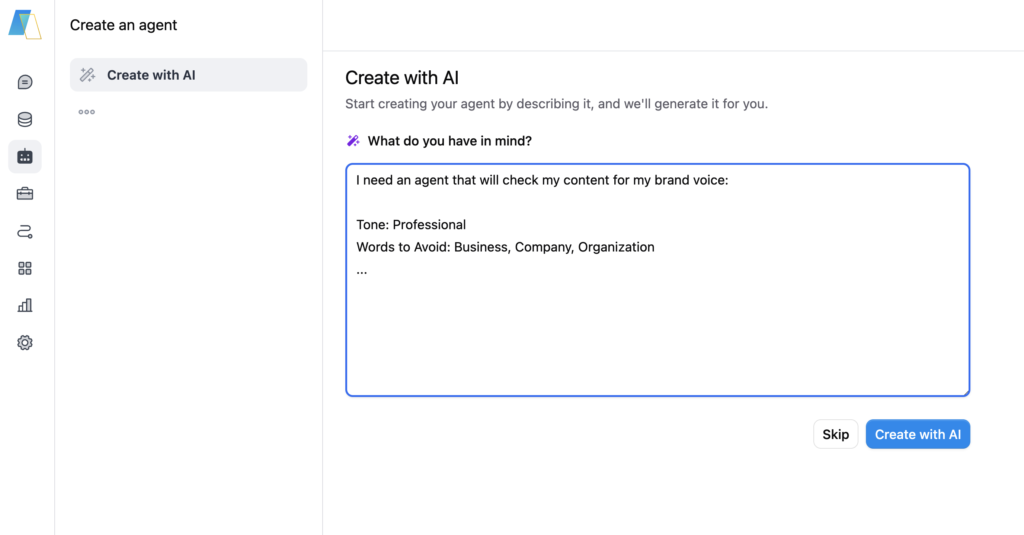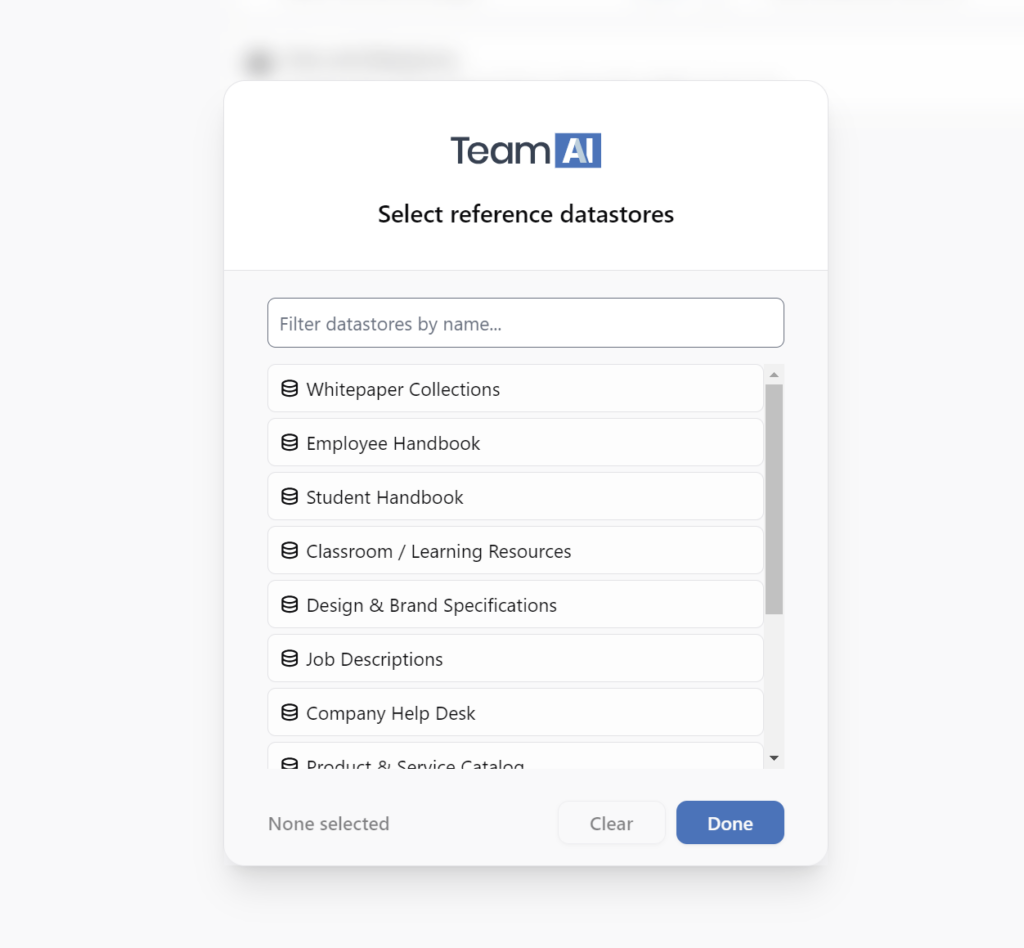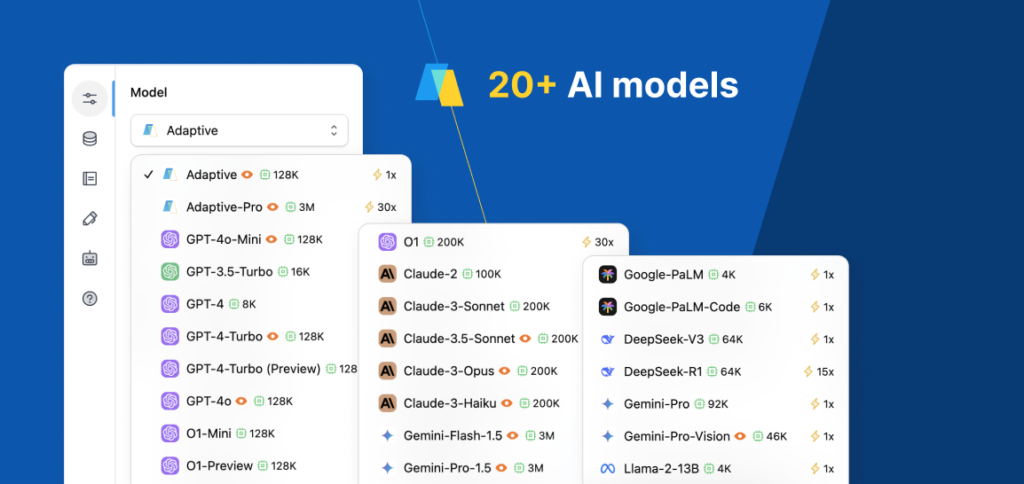Businesses and organizations are seeking flexible platforms to build and deploy custom AI agents that enhance productivity across teams and departments. While Google Agentspace has emerged as a notable solution in this space, TeamAI offers a comprehensive, user-friendly, no-code alternative to building AI agent libraries.
This guide provides a detailed walkthrough on how to build customized AI agent libraries in TeamAI that can meet the promise met by Google Agentspace for many businesses, without the limitations of early access programs or enterprise-only availability.

Above: A full library of AI agents built to provide help desk knowledge to a full team.
Why Choose TeamAI Over Google Agentspace?
Before diving into the step-by-step instructions, let’s understand what makes TeamAI a compelling alternative to Google Agentspace:
| Feature | TeamAI | Google Agentspace |
| Availability | Generally available to all users | Currently in early access with limited availability |
| Pricing model | Transparent, accessible pricing for businesses of all sizes | Enterprise-focused, pricing not publicly disclosed |
| Setup time | Create agents in minutes with intuitive interface | Requires Google Cloud environment setup |
| Deployment options | Web, mobile, Chrome extension, and API access | Primarily integrated with Google Workspace |
| Entry barriers | Low technical requirements for getting started | Requires Google Cloud knowledge |
TeamAI empowers businesses to create specialized AI assistants designed for specific tasks with precision and efficiency, similar to Google Agentspace’s vision, but with greater accessibility and lower barriers to entry.
Materials or Requirements
To build an AI agent in TeamAI, you’ll need:
- An active TeamAI account (no waitlist unlike Google Agentspace)
- A clear understanding of the task you want your agent to perform
- Optional: PDFs, website URLs, or other documents for your agent to reference
- Optional: TeamAI Chrome extension for accessing agents across the web
- Optional: Mobile app for accessing agents on mobile devices (coming soon)
Step-by-Step Instructions
1. Understanding AI Agents in 2025
Similar to Google Agentspace, TeamAI’s approach to AI agents involves creating specialized assistants that can:
- Access both internal and external knowledge bases
- Utilize tools like web search and code interpretation
- Maintain consistent responses
- Execute specific tasks with precision
While Google Agentspace focuses on enterprise-wide deployment through Google’s ecosystem, TeamAI provides a more adaptable and customizable platform that works seamlessly regardless of your existing tech stack.
2. Accessing the Agent Builder

Unlike Google Agentspace which requires navigating Google Cloud interfaces, TeamAI makes agent creation straightforward:
- Look for the “Agents” section in the left-hand sidebar (third option down)
- Review existing agents for inspiration
- Click the “Create Agent” button to begin
TeamAI also offers an AI-assisted creation option similar to Google’s Agent Designer, helping beginners quickly generate a starting point they can refine.
3. Setting Up a Data Collection (Optional)

With simple upload functionality or website-syncing, TeamAI enables powerful knowledge integration:
- Navigate to “Data Stores” in the left sidebar
- Click “Create Collection” and give it a descriptive name
- Within your collection, create a data store
- Add documents by uploading files or syncing websites
TeamAI’s approach to data integration matches Google Agentspace’s retrieval-augmented generation (RAG) capabilities but with a more intuitive interface that doesn’t require understanding complex vector databases or GraphRAG concepts.
4. Defining Your Agent’s Purpose
Similar to Google Agentspace’s agent creation workflow:
- Give your agent a descriptive name that clearly indicates its purpose
- Add a detailed description including keywords for searchability
- Consider using the AI agent generator for assistance with initial setup
TeamAI’s search functionality ensures that agents are discoverable across your organization, just like Google Agentspace’s centralized agent repository.
5. Writing Agent Instructions
This is where TeamAI truly shines as a Google Agentspace alternative. While both platforms allow for detailed agent instructions, TeamAI’s system is more approachable:
- Start with the task description – clearly state what the agent should do
- Define tone and style for communications
- Add definitions for specialized terminology
- Specify available tools and when to use them
- Outline step-by-step procedures for handling common scenarios
- Add critical policies that the agent must follow
Google Agentspace emphasizes enterprise-grade guardrails, while TeamAI gives you direct control over your agent’s behavior without needing to understand complex AI safety concepts.
6. Selecting the AI Model

TeamAI offers model flexibility similar to Google Agentspace’s model options:
- Consider your agent’s task when selecting a model
- Review the recommendations to understand each model’s strengths
- For general-purpose agents, the “Smart Model” provides a good balance
- For specialized tasks, consider models optimized for specific functions
While Google Agentspace leverages Google’s Gemini models, TeamAI provides access to multiple leading models without locking you into a single AI provider’s ecosystem.
7. Configuring UI Elements
TeamAI’s UI configuration provides a more customizable experience than Google Agentspace:
- Enable starter buttons for quick-access prompts
- Create an opening statement for agent introduction
- Add starter questions as buttons for users to click
- Ensure instructions address these starter questions
These features guide new users toward effective interactions with your agent, creating a smoother user experience than Google Agentspace’s more standardized interface.
8. Selecting Tools for Your Agent
Both TeamAI and Google Agentspace recognize the importance of tools that extend agent capabilities:
- Web Search: Search online for information (similar to Agentspace’s Chrome integration)
- Retrieval: Extract information from URLs or uploaded content
- Code Interpreter: Run complex calculations and visualize data
- Image Generation: Create images based on descriptions
TeamAI’s tool selection process is streamlined and doesn’t require understanding Google Cloud’s complex permissions system.
9. Connecting to Your Data Hub
Data connection is where TeamAI offers significant advantages over Google Agentspace:
- Navigate to the DataHub section during agent creation
- Select collections you want your agent to access
- Use “Sync Tree” to include all documents within collections
- For finer control, select specific documents within collections
While Google Agentspace focuses on connecting to Google Workspace, TeamAI allows broader integration with various data sources without the complexity of Google’s enterprise data permissions.
10. Publishing and Testing Your Agent

The final stage of bringing your agent to life:
- Review all settings on the final review page
- Click “Publish Agent” to make it available
- Use the debug/preview interface to test responses
- Ask questions related to the agent’s purpose to evaluate performance
- Note any responses that need improvement
Unlike Google Agentspace’s enterprise deployment model, TeamAI agents are immediately available through multiple channels, including web, mobile, and Chrome extension.
Tips and Warnings
Tips:
- Use descriptive names and detailed descriptions for better agent discoverability
- Be specific about when and how to use different tools
- Include examples of ideal responses in your instructions
- Start with simpler agents before attempting complex implementations
- Test thoroughly with various questions to ensure consistent performance
Warnings:
- Agents are only as good as their instructions – vague guidelines lead to inconsistent performance
- Without proper data connections, agents may lack necessary information
- Be cautious about enabling too many tools, as this can make responses less focused
- Changes may take a few minutes to fully propagate through the system
- Web-synced data only updates periodically, so consider this for time-sensitive information
Conclusion
TeamAI offers a compelling alternative to Google Agentspace for businesses looking to harness the power of AI agents without the complexity and enterprise-focused limitations of Google’s platform.
By following this guide, you can create specialized assistants that access your internal knowledge bases, leverage powerful tools, and provide valuable assistance across your organization.
With TeamAI, you benefit from immediate availability, transparent pricing, intuitive interfaces, and flexible deployment options—all without the waitlists and enterprise requirements of Google Agentspace. As both platforms continue to evolve, TeamAI remains focused on democratizing access to advanced AI agent capabilities for businesses of all sizes.
